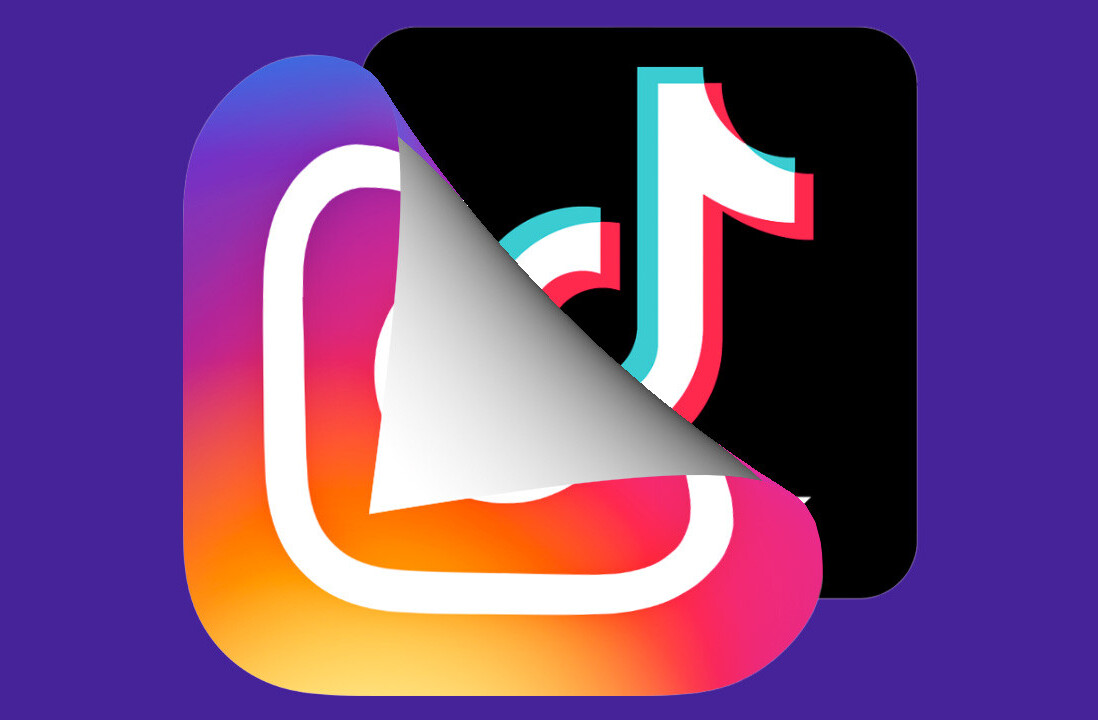
For businesses and brands, social media is a relatively new marketing platform that’s grown exponentially over the past few years. It’s not all just poking and tweeting, but it’s a platform where brands can take advantage of realtime, engaged two-way conversation with their customers and industry peers. And investing intellectual and financial resources into social media has never been more important for brands, as experts say social media is on target to be a $30 billion industry (per year) by 2015.
Hiring talent who can take your brand from 1 fan to 1 million is a major factor in determining your business’s success or failure. We tracked down the globe’s finest social media managers behind brands such as Virgin America, The New York Times, Gizmodo, Flavorpill, Thrillist, TOMS, NASA, Intel, Etsy, HowAboutWe, Vanity Fair, Samsung, Fast Company, ELLE and even interviewed our very own Amalia Agathou from The Next Web. These aren’t just talented marketers. These are human beings pioneering a new profession.
When an issue arises, these are the men and women that have to spring into action. Do they use Hootsuite, Radian6, CoTweet, Vitrue or Awareness for social media monitoring? Where do you spend the most time? How do you keep conversation colloquial yet still professional? How do they encourage user-generated content, commenting, gamification, social aggregation and what’s the art of content curation? And what about geolocation? Are they on Facebook, Twitter, Foursquare, Trumblr, Gowalla, Loopt, SoundCloud, Slideshare, vYou, Flickr or even GetGlue? What do they think of Google+? Which is their fastest growing media account? And do you ever sleep? We ask them here.
Virgin America: Jill Okawa Fletcher and Nick Schwartz
Virgin America is a great example of a brand that always uses personal signage when reaching out to customers. The two-person team behind one of the world’s most loved brands knows to talk to customers like a friend, not a corporate entity.

In December 2008, Nick Schwartz saw an ad on Craigslist for a social media intern at Virgin America. Now, two and half years later he is Virgin America’s Social Media and Communications Ambassador and he shares the responsibility with his colleague Jill Okawa Fletcher.
Fletcher came onboard over a year ago from Virgin Mobile, where she was working on music marketing campaigns surrounding digital mobile. She moved into social media as it was becoming a bigger space. While Schwartz is the day-to-day voice, Fletcher works more strategically behind Virgin America’s social media and digital campaigns. The two are pictured below at Virgin America Day at the SF Giants game where they ran the Twitter Scavenger Hunt using the #FlyTheBeard Hashtag.
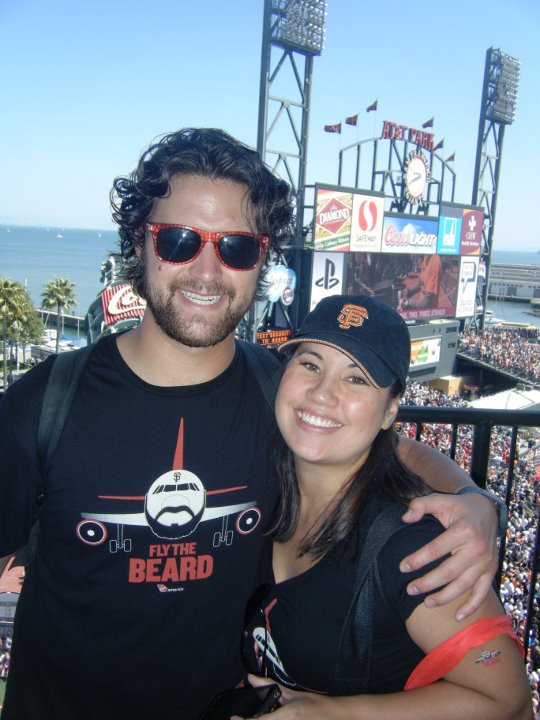
Nick Schwartz: From the beginning I spent a lot of time watching Richard Branson’s interviews to figure out what kind of tonality he has. The company is a startup airline. And at the time I came on, we were working our way towards fleet-wide WiFi. We had people tweeting and Facebooking all the time. So we have to be on call, and be watching the seats at all times. And it’s still just the two of us.
Jill Fletcher: We work closely with the guest relations team as well but we don’t get a lot of sleep. We tweet a minimum of 4 push messages a day and all of the @replies, DMs. Then we post on Facebook a couple of times a day.
NS: Although, it can fluctuate with the weather.
CBM: What was you worst day ever on the job?
JF: We had a tough time last winter with all the snow and cancellations on the East Coast. Thankfully, we weren’t flying into Chicago yet and I’m glad we dodged that bullet.
NS: What can really raise anxiety for us is waiting to get in communication with operations. Basically we can only reach out to tell people, ‘We understand you’re upset,’ but we don’t have much else to tell them. We have to be that cool voice of reason and explain it in more of a human tone.
CBM: How many people have asked you for free flights and upgrades?
JF: A lot. We have random people friending us on Facebook or LinkedIn all the time asking that. Our first class cabin is still really small compared to other airlines, so it’s challenging for us to help people in special situations. We have to work closely with guest relation on all matters.
CBM: Would a person’s Twitter follower count affect how you treated them?
JF: We certainly are cognizant when that happens but we really have to stay consistent in our offerings to people who are all facing similar circumstances.
CBM: Who are the biggest celebrity fans of Virgin America?
JF: The fact that were based in Silicon Valley has granted us a lot of fortune in terms of our digital celebrities that fly with us. We’re close friends with the companies here and have a great relationship with Twitter. Our biggest celebrity fans include Dick Costolo (Twitter) and Kevin Rose (Digg). We’re really lucky to have a passionate following of people, they even help us close sales without us prompting them too.
The New York Times: Elizabeth Heron and Lexi Mainland
CBM: How did each of you come to work at The New York Times?
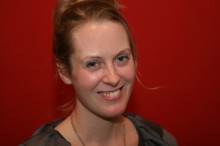 Liz (pictured right): I came to The Times a little over a year ago to work on an incipient social media team, after a short stint covering online trends for ABC News and five years at The Washington Post. I fell in love with the journalistic power of social media during my time as the Foreign Innovations Editor at The Post, where I directed our online coverage of several major stories — the Iran revolution, terrorist attacks in Mumbai, the war in Afghanistan, and the devastating earthquake in Haiti, among others — that relied heavily on nontraditional sources like Twitter, YouTube and Facebook.
Liz (pictured right): I came to The Times a little over a year ago to work on an incipient social media team, after a short stint covering online trends for ABC News and five years at The Washington Post. I fell in love with the journalistic power of social media during my time as the Foreign Innovations Editor at The Post, where I directed our online coverage of several major stories — the Iran revolution, terrorist attacks in Mumbai, the war in Afghanistan, and the devastating earthquake in Haiti, among others — that relied heavily on nontraditional sources like Twitter, YouTube and Facebook.
Lexi (pictured below on right): This is my sixth year at The Times. Before I came here, I wrote, produced and edited news and documentary TV and Web content at PBS. At The Times I’ve worked on several desks, but for four years was a Web journalist embedded on Metro. My time there spanned three different New York governors and the dramatic downfall of Eliot Spitzer, but two of the projects I’m most proud are the launch in 2007 of City Room, which has consistently been one of The Times’s most popular blogs, and the creation of One in 8 Million, a yearlong multimedia and print series that won The Times its first Emmy last year.
CBM: What’s your day to day like and what tools do you use?
 L&L: The first thing we do every day is try to get a sense of what stories — both from The Times and other sources — are percolating on the web. We each use Tweetdeck and sites such as LikeButton.me to monitor our own feeds as well as the wider conversation. We attend the morning news meeting to hear what’s coming down the pike and identify which stories will spark conversation or afford us opportunities to do something special on Twitter and Facebook. Throughout the day, in between our many other responsibilities, we’re trying as much as we can to lend a personal voice to the main @nytimes Twitter feed and to amplify the voices of our journalists who tweet. A typical day could include helping a reporter crowdsource a story, creating a hashtag game and blogging about the results, or working with desks to live-tweet a major news event.
L&L: The first thing we do every day is try to get a sense of what stories — both from The Times and other sources — are percolating on the web. We each use Tweetdeck and sites such as LikeButton.me to monitor our own feeds as well as the wider conversation. We attend the morning news meeting to hear what’s coming down the pike and identify which stories will spark conversation or afford us opportunities to do something special on Twitter and Facebook. Throughout the day, in between our many other responsibilities, we’re trying as much as we can to lend a personal voice to the main @nytimes Twitter feed and to amplify the voices of our journalists who tweet. A typical day could include helping a reporter crowdsource a story, creating a hashtag game and blogging about the results, or working with desks to live-tweet a major news event.
CBM: How has your work affected Twitter and Facebook growth?
L&L: @NYTimes on Twitter is what we call a “cyborg account,” meaning it’s a combination of automated homepage headlines and manual tweets, retweets and replies done by Lexi and Liz. Since we became the social media editors, we’ve put a greater emphasis on humanizing the main account. Anecdotally, interacting with the @nytimes community more heavily has increased the level of engagement and the reach of our journalism on social media. We’ve also learned a lot from curating the @nytimes account that has informed how we strategize with individual news desks. In this time, we’ve seen our follower count grow to over 3.6 million on Twitter. On Facebook, The Times’ strategy of posting the most shareable stories of the day to our main page, asking a lot of questions, and closing the loop with subsequent stories based on those interactions has helped us grow that community to over 1.5 million fans.
CBM: Which of your accounts is growing the fastest?
L&L: We don’t think follower counts are necessarily the best measure of engagement. We prefer to look at the quality of interactions we spark among our fans and followers, and by that metric, the main Twitter and Facebook pages are growing nicely. Where we have seen a big uptick in followers is to our section-specific Twitter accounts, such as @nytmetro. We believe the increase is due to the fact that more of those accounts are being actively curated by journalists throughout the day.
CBM: What have been your biggest struggles and how have you overcome them?
L&L: Twitter is a 24-hour medium, and there are only so many hours in the day that two editors can do the kind of thoughtful tweeting we believe it deserves. So, time can be a struggle. We’re overcoming that by thinking of ways to build smart tools in the newsroom and involve other editors in our social media efforts. Another challenge is the sheer volume of content we produce a day — more than 200 individual pieces — much of which would do well with our Twitter and Facebook audiences. We handle this embarrassment of riches by choosing the most shareable and interactive content for the main accounts, while thinking of smart ways to surface other content with section-specific accounts.
CBM: What tips and tricks have you learned in your time working in social media for The Times?
L&L: Always cite your sources, even (or especially) in 140 characters. Think before you retweet. Don’t be afraid to correct the record or admit you made a mistake. Respond to people who tweet to you — you get from social media what you put into it. Even though social media is a virtual medium, never underestimate the journalistic value of putting a reporter who uses social media well where the story is actually unfolding.
Gizmodo: Christopher Mascari
 While an editorial assistant for Gizmodo in New York City, Christopher Mascari organized the epic 5-day Gizmodo Gallery event in September 2009. Later that fall, he noticed Gizmodo wasn’t doing much with its Facebook and Twitter profiles, and that the brand was seriously missing out on traffic and a connection with readers. He started to build up Gizmodo’s Facebook page and use it to promote their biggest stories and event coverage. At the time, it had just 1,000 fans. Mascari, who had moved back to his L.A. homeland, pitched then editor-in-chief Brian Lam and said, “Hey, what are the chances I could do this for Giz as a solid part-time job and over see all of Giz’s promotional efforts?
While an editorial assistant for Gizmodo in New York City, Christopher Mascari organized the epic 5-day Gizmodo Gallery event in September 2009. Later that fall, he noticed Gizmodo wasn’t doing much with its Facebook and Twitter profiles, and that the brand was seriously missing out on traffic and a connection with readers. He started to build up Gizmodo’s Facebook page and use it to promote their biggest stories and event coverage. At the time, it had just 1,000 fans. Mascari, who had moved back to his L.A. homeland, pitched then editor-in-chief Brian Lam and said, “Hey, what are the chances I could do this for Giz as a solid part-time job and over see all of Giz’s promotional efforts?
He flew back out to New York City to discuss the position with Gawker Media founder Nick Denton, who offered him a full-time job doing just that– but for all of Gawker’s properties. Gizmodo now has over 250,000 Facebook fans, a quarter of the 1 million Facebook fans that Gawker currently boasts across all its sites.
CBM: How did last night go for you? (When Steve Jobs resigned.)
Chris Mascari: That was fun! I was just about to transition into slowing down my day and then I started to see all the news and instantly went into promotional mode. I know what needs to get done and I do it and before you know it, 5 hours are gone. It’s fun, and reminds me of live blogging a key-note for Gizmodo. It’s more about just instantly knowing what you need to do. There’s no part of my brain that’s complaining. It’s more about keeping my head down and pushing through.
CBM: How would you describe your role as Gawker’s Editorial Marketing Manager?
CM: I oversee all of our social integration and social outlets for Gawker Media. I don’t have a hands on approach for all their sites as we allow sites to push their pages on their own. When a Gawker site has an exclusive or breaking story, we hand-pick writers who we know would enjoy seeing a link to that story before everyone else. So like, “Hey, Gizmodo had this story that might be worth checking out.” We do it very sparingly, maybe once a week, many none in one week, sometimes 5. But I’m highly against doing PR emails.
I usually worry about the post story stuff. I make sure it’s on their social pages and put it front of the right people. In the last year, sites have gotten much more involved with their own Facebook and Twitter pages. When I started almost two years ago, sites didn’t embrace their social pages and social outlets like they do now. So it was my job to ask, “How do I get editors to worry about these things?”
In short, I make sure a story doesn’t get left behind online.
CBM: Which Gawker property does the best job at promoting its stories on social media?
CM: Lifehacker does the best job. If you look at their Facebook page, you’ll see the manually enter updates. They have really good connection with their readers, which is apparent when their readers respond to them.
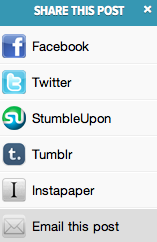 CBM: Can we talk about the new design’s share buttons?
CBM: Can we talk about the new design’s share buttons?
CM: Sure, one of the most important things to me in terms of social buttons is to have tracking on button clicks to see what is being clicked on each story. This way, we can actually see what’s worth having in a share module. Facebook Share is always the highest. Most surprisingly, the email button is clicked 2nd or 3rd on the list.
CBM: What was your life like post-iPhone 4 theft last year?
CM: It happened a few months after I started as Editorial Marketing Manager at Gawker Media. Since I’d been at Gizmodo I was close with Jason Chen and Jesus Diaz so we had a plan about how we would package the story and promote it. Minutes before the story broke, I sent out emails to every major tech journalist. We didn’t expect there to be this huge nationwide coverage.
We were inundated with media requests at a time when we didn’t have a PR manager. My phone was ringing non-stop from booking editors for TV spots. It was an unbelievable week and a half of non stop action. We didn’t have to do anything, everyone coming to us and saying, “We want you on TV.”
CBM: Did you keep your cool?
CM: Yeah, Yeah. It’s just work. Anything I do, I relate to working an Apple Live Blog. I always thought Gizmodo had the best live blogs. As soon as you shoot an image, you have to know if it’s good or not and you’re uploading an image in seconds. You have to be writing faster than real-time. Nothing can be as hectic as that ever.
CBM: How would you describe your best day ever?
CM: Ha, I don’t know. Any day when we’re eating Torrisi for lunch is usually my best day.
Flavorpill: Russ Marshalek
Flavorpill is a city guide for those who like to experience new and exciting things.
Russ Marshalek got his start as the marketing and PR director of a large-scale bookstore in Atlanta, Georgia. In search of the big city, in March 2009, he decided to moved to New York City as a social media freelancer. When the opportunity to work at Flavorpill arose it seemed like a dream come true.
“I’ve always been into art, music and culture so my interests directly line up with Flavorpill,” he says.

CBM: Are you glad you moved to New York City?
Russ Marshalek: I love living in New York, above and beyond. Every day there’s another reason to love living here.
CBM: What’s your daily routine like?
RM: Regardless of how much I’d like to have everything standardized, it really depends. Essentially my life is plotted out by my Hootsuite dashboard. I’m interacting with our readers and followers most of the day and it’s a lot of communication in Gmail.
CBM: As Flavorpill’s Social Media Director, what are your tips and tricks?
RM: You have to be sincere and you have to know your audience. People think you can just broadcast to your audience what it’s going to like and avoid conversation but it’s really not the case. In social media for a media company, you really have to do something new that sits within that framework.
For example, we use Tumblr, we avoid only posting our own content or reblogging what thousands of people have already seen. We take great posts on Flavorwire or an interesting event on Flavorpill and translate that to Tumblr. We also post a lot of weird art. The weirder, more obscure art pieces that always bear a 2nd, 3rd or 4th glance. Currently, Tumblr is our fastest growing social account.
Our eventual goal is to make the entire Flavorpill experience social. When you interact with our Facebook, Twitter or Tumblr, you’re going to get a live human. We actively care and actively know that our social accounts need to act like the ears and eyes for our audience.
“Don’t miss David Pessah of Thrillist’s social media. It’s super smart. It’s in such a voice that when you read something by Thrillist, you know you’re reading a Thrillist post,” says Flavorpill’s Social Media Director Russ Marshalek.
Thrillist: David Pessah
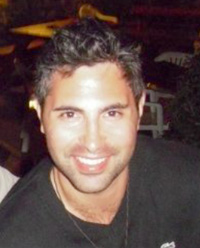 In 2006, David Pessah started his career as a strategic web consultant. While at a Mediabistro party in 2009, he ran into the guys from Thrillist and convinced them to hire him as an intern/consultant a couple of days a week. Two years later, Pessah is now engaged in a full blow social media career and is fulltime at Thrillist.
In 2006, David Pessah started his career as a strategic web consultant. While at a Mediabistro party in 2009, he ran into the guys from Thrillist and convinced them to hire him as an intern/consultant a couple of days a week. Two years later, Pessah is now engaged in a full blow social media career and is fulltime at Thrillist.
CBM: How do you distinguish Thrillist’s James Dean meets Frat boy voice from competitors like Flavorpill and Urban Daddy?
David Pessah: We’ve always had a unique voice. It began as a blend of Ben’s and Adam’s* personalities. One of the reasons I stuck around is that I can write in that voice. I’m not sure how to describe it, it’s kind of something I’ve always gotten it. It’s the way I talk and the way my friends talk. Just like 28-year old dudes.
*Thrillist founders Ben Lerer and Adam Rich
CBM: What’s your day to day like?
DP: It’s fun. It’s a lot of work. It involves everything from interacting with customers on Twitter, updating Facebook posts, writing Foursquare tips, Tumblr posts and setting up promotions that run across all of our social media channels. For example, right now we’re giving away an iPod loaded with Blink 182’s entire catalog to promote their cross-country tour. It’s really about connecting with fans engaging with our content. I do my best to connect with everyone that mentions Thrillist on Twitter.
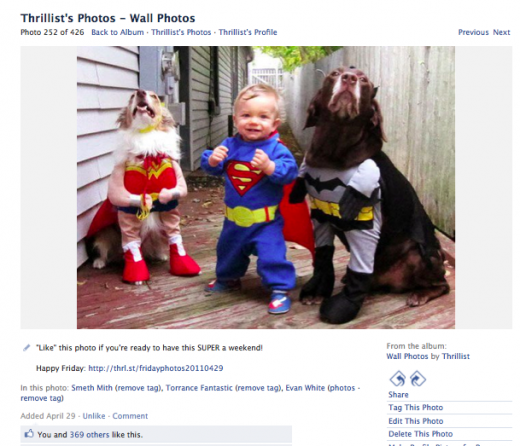
CBM: Thrillist’s Foursquare presence is really impressive. Tell me how that started.
DP: We were in there pretty early. In fact, we were one of the first major brands on Foursquare. We take our best content, all the super tip worthy, interesting and notable stuff about a venue and put it out there to reach a different audience and get people interested in the brand. We’re nearing 1,000 tips all over the country in every market that were in. We even have a street team now helping us to publish Foursquare tips.
CBM: What tools do you use on a daily basis?
DP: Hootsuite, 100%. The rest I use through the browser, for example, I keep everything inside of Google Docs.
CBM: What are your favorite apps?
DP: Foursquare, Venmo, GroupMe, Uber and Dropbox. And Spotify, which I didn’t think I was going to dig.
CBM: Why?
DP: I am a huge music fan, but I never really hooked onto music social networks like MOG or LastFM. Anything that tried to be super niche-y lost to Facebook. But I love the social stuff in Spotify- the ability to create playlists with your friends is awesome. I also love Google Music.
CBM: How much of your job as a Social Media Manager bleeds into real life?
DP: A ton. I’ve met really random and interesting people just by tweeting about things and I really like meeting those people in real life, especially the ones that I talk to frequently online. I try to do coffee meetings at least 2-3 times a week. Also in real life, David is launching a sweet new t-shirt company, check it out here: “Children of Privilege“.
 CBM: How awesome is it to work at Thrillist?
CBM: How awesome is it to work at Thrillist?
DP: We have Nerf Gun Fights. In fact, we have an entire arsenal. There’s so many awesome, awesome people. Seriously, everyone is the best at what they do. And a few weeks into the job a baby lion came to our office. No joke.
TOMS: Caitlin Coble
Be wary of “social media experts!” Working in social media is a learning process and it’s an ever evolving space. I spend a lot of my day reading, catching up on news and looking up what other brands are doing. There’s something to learn everyday, new platforms to try and new technologies to discover.
-Caitlin Coble
CBM: What is it like working for one of the world’s most loved brands?
Caitlin Coble: I am the most fortunate person to be working at TOMS. I’ve been here over 3 years and watched it grow from 30 hustling employees to a full warehouse, spilling over into other offices at this campus in Santa Monica, California. Doing social media for a brand like this is the most amazing thing because I get to see how people are reacting to One for One and how they’re inspired every day by the stories that we’re sharing. I spend a lot of my day capturing and figuring out how to share those stories. I really have a dream job.
CBM: How did you end up at TOMS?
CC: I had a fashion internship at Nylon Magazine in New York City. I wore TOMS around all the time, so my editor asked me if I wanted to attend a Press Day for TOMS and write about the product for the website. I bought two new outfits for it, I was a nervous wreck! But I walked in with confidence, because I wanted to be seen as an editor, not an intern! I interviewed Blake [Mycoskie, CEO] for the website. The last thing I asked him was, ‘How do I come work for you guys?’ About two weeks later, I was flying home to Florida and driving across the country to start my job at TOMS.
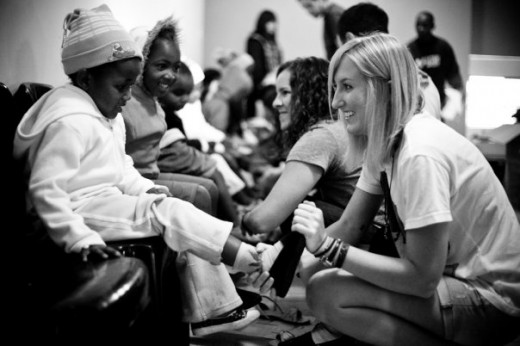
CBM: What was your first pair of TOMS that you bought?
CC: I have them sitting behind my desk. I refuse to throw them away. They’re blue and white checked, and completely destroyed.
CBM: What’s your day to day like as TOMS Social Media Manager?
CC: It’s a little bit of eavesdropping, running around and asking other departments what they’re working on and if it’s something to share on our Facebook page. A lot of our content revolves around the stories from our Giving Partners. For example, we recently had the Cambodian Children’s Fund visit TOMS HQ and that was a perfect story to share on our Facebook wall.
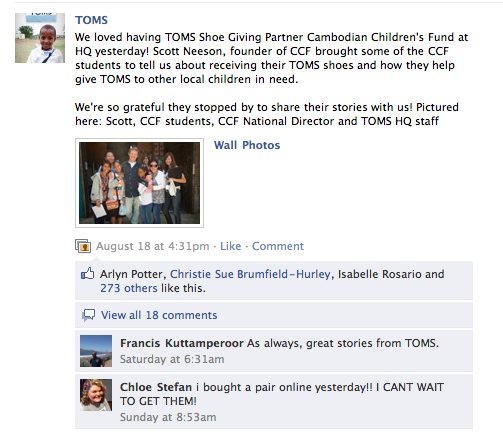
CBM: What tools do you prefer to use in social media?
CC: I use Hootsuite to keep track of what’s happening on Twitter. We use SpreadFast to help out with analytics and monitoring. I have an amazing coordinator who’s better than any social media tool you can get.
CBM: This summer you launched TOMS Eyewear, which for every pair of sunglasses purchased, TOMS helps give sight to a person in need. Tell me about the launch.
CC: The TOMS Eyewear launch has been fun. It’s brought me back to when we were so young before when I used to say, “It’s a shoe company, let me tell you about it.” Now, everyone knows TOMS Shoes, but I get to tell them about TOMS Eyewear. It was the most secretive project ever. There was this small team of people in this loft with closed blinds in our offices for months and months. Most of the company did not know anything about it before the day we launched. When it launched, I remember Blake saying: “Look at the difference we’ve made with the One for One movement and shoes, it’s our responsibility to try to address other needs with this model and new products.”
NASA: Stephanie Schierholz
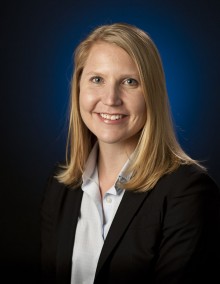
For a government agency, NASA is a clear winner in social media. The space agency is on Twitter, Facebook, Foursquare, Gowalla, Flickr, UStream, YouTube, SlideShare and even MySpace. The first check in from space? It happened via Foursquare from NASA.
You can find all of NASA’s social channels via its Connect page on the NASA site. NASA Social Media Manager Stephanie Schierholz is the woman behind these accounts.
CBM: How did you come to work at NASA?
Stephanie Schierholz: I applied four times, starting in 2006. I was finally hired as a public affairs specialist with NASA.
CBM: NASA has its greatest following on Twitter (1.3 million followers). Why do you think that is?
SS: We set up Twitter first because it made more sense as far as reaching out and with the way we share content, which is a lot of Web resources. Twitter acts more like a newsfeed.
CBM: What do you think of Google+?
SS: I’ve been playing around but Google+, but it does not have an agreed upon TOS with the government so we can’t go there just yet.
CBM: What tools do you use to manage all of your accounts?
SS: 15 people, including public affairs officers have access to the Twitter and Facebook page so it varies for each office. I work at Headquarters and use CoTweets. And at various times we use a mix of others including Hootsuite, Tweetdeck, Twitter.com and Facebook.com.
CBM: Have you ever experienced a social media meltdown?
SS: Our account @NASA_Astronauts was hacked. Someone posted a few tweets about TVs on sale. We caught it within 10 minutes and were able to quickly sieze back control. One day one of our center’s Facebook pages disappeared from the Facebook universe for a while, but luckily it was just a glitch in Facebook’s system.
Perhaps most impressive are NASA tweetups over the past 3 years, where followers of the @NASA Twitter account are invited to one of the events. The Juno launch Tweetup participants below pose for a group photograph with NASA Administrator Charles Bolden with the Vehicle Assembly Building on Friday, August 5, 2011, at Kennedy Space Center in Cape Canaveral, Fla.
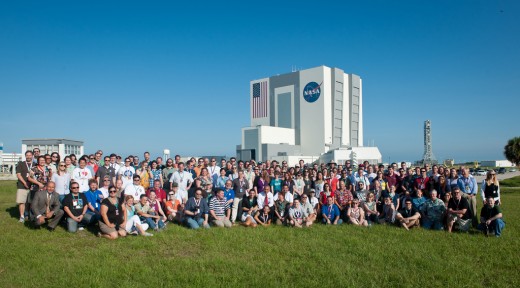
For an in-depth interview with Schierholz read: The history and future of NASA’s social media strategy, an epic article by TNW’s US Editor Brad McCarty.
Intel: Bryan Rhoads and Ekaterina Walter
![]()
Intel is everywhere and nowhere at the same time. It’s underneath you finger tips, but you can’t see it. It’s not something you’d buy in a store per se, yet you’ve bought thousands of dollars worth of its product in your lifetime. Intel is the world’s largest semiconductor chip maker, (based on revenue) in the world, serving as the foundation for the world’s computing devices.
So, how do you rep a brand like Intel? We caught up with Ekaterina Walter and Bryan Rhoads who do just that. Rhoads is Intel’s Global Consumer Social Media Manager and Ekaterina Walter (E for short) is Intel’s leading social networking strategist who focuses on Facebook and YouTube.
CBM: How did you react when Intel UK’s Twitter account was hacked?
Bryan Rhoads: We learned we have to have more secure passwords.
Ekaterina Walter: When something gets hacked, we escalate it globally. We had an experience when our Facebook pages were hacked and we gave folks 10 tips on how to address it going forward.
BR: We have a process in place for our social media practitioners. When someone leaves, we change the passwords to all the accounts.
CBM: You’ve managed to grow to an impressive 2.8 million Facebook fans in just two years. What’s changed during that time?
E: Facebook’s policies change literally every Tuesday. Changes to its promotion guidelines had the biggest impact on us from a time and cost perspective. It used to be that you could give away anything pretty freely. But now, if you give away anything on Facebook, you have to fill out an application, which is both costly and timely. This really hurt our realtime creativity. For example, if we wanted to institute something or celebrate a surprising milestone we can’t spontaneously give away a prize. We also can’t feature winners on our Newsfeed.
CBM: How do you tackle the timing of your posts on Facebook?
E: We try to address the timing and urgency in advance as much as we can and we try not to post more than once a day. We know there’s a threshold and don’t want to bombard people with links. I’ve found that posts with media like photos and videos work the best.
CBM: What’s going on with the Intel YouTube channel?
E: We first redesigned our branded YouTube channel in 2008 and we’re now working on a completely customizable channel. Since the beginning of the year, we’ve coordinated the Visual Life campaign across YouTube, Facebook and Intel.com.
Watch this Visual Life segment on fashion photographer and blogger Scott Schuman of The Sartorialist.
BR: It was amazing to see the reaction from emerging markets versus for the Visual Life campaign. We have much more participation in our newer markets and developing markets, particularly Brazil and Russia. Is it because first world markets are jaded and there are too many campaigns out there asking for their attention? Perhaps. But the response from Russia and Brazil blew us away.
Etsy: Dave Brown
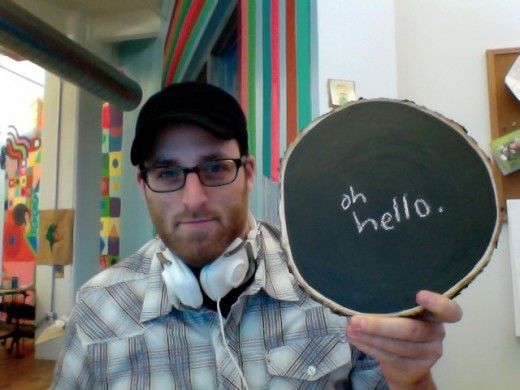
Etsy, one of the older children in the New York City tech scene, is currently heading toward 1.5 million followers on Twitter and 500,000 on Facebook, thanks very much in part to Dave Brown, ping-pong player by day and Etsy’s social media manager when he’s not playing ping-pong. And at Etsy, social media is very serious business as traffic from social media generates an average of $3.5 million in gross merchandise sales per month for Etsy Sellers.
CBM: What’s it like to work for Etsy in social media?
Dave Brown: I think about 2 days after I started at Etsy, I wrote its long-term strategy for the social media. There was no one taking ownership of social media before I got here. It’s been great to execute it and see it through. According to Brown, Etsy has one simple social media strategy:
“Etsy’s social media strategy empowers the world to feel good, inspire creativity, and promote handmade.”
CBM: By how much have you grown Etsy’s social media accounts and how did you do it?
DB: Since I started, there’s been an increase across the accounts over 280%. There are a lot of factors that are unique to our business model. We are such a unique business as we have over 800,000 entrepreneurs selling on our platform and they’re all marketing as well and utilizing Twitter as well as new platforms like Pinterest. So, it’s not just me. It’s a collaborative effort. I just help orchestrate it.
It’s important to note that we’re not just robots behind Twitter and Facebook. We also have names and we love entrepreneurship, DIY, music, art and design and anything hand-made. I’ve found the sweet spot where we’re posting 7-9 times during the week day and less on the weekends. For every 2-3 posts related to Etsy I throw in a creative nugget– a piece of content that isn’t a traffic driver for Etsy but has something to do with Etsy’s philosophy– basically just things we find on the Internet that are really interesting or cool things people are doing. I’ve also been a big fan of experimentation I try timing, repetitions, new platforms, new apps, and am always doing a ton of research and keeping up with what’s going on in the world of tech and social media.
CBM: What apps and platforms do you use and love?
DB: I love Instagram, Tumblr, Pinterest and Evernote. Tumblr has been awesome for us. We don’t have a presence just yet on Instagram but we’re looking into it. Things are moving so fast and it’s so exciting. I’m definitely keeping my eye on what Google+ is doing and how we can use that in a creative way instead of repurposing content you might find on our Facebook and Twitter.
When I get home from Etsy, I geek out on the iPad. It’s such an awesome tool for digesting content. Everyone is digesting content in multiple ways. Some are grabbing it through Facebook and Twitter, some through apps like Pulse and Flipboard.
CBM: Would you still call Etsy a startup?
DB: Well, we’ve been around for over 6 years now and there are over 200 people in our NYC office, and a few more employees in our small office in Berlin. We have millions of members on the site. So while we’re bigger than your average startup these days, there’s still the mentality here that makes Etsy feel like a startup.
HowAboutWe: Michelle Dozois
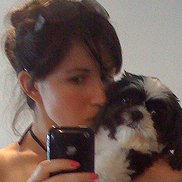 Michelle Dozois was the first hire at HowAboutWe in June of last year. Her role was to start building the dating site’s social media presence, such as finding cool date ideas and engaging people about the site’s content. Now her role has evolved into being the editor of The Date Report and she has a few full-time writers on staff.
Michelle Dozois was the first hire at HowAboutWe in June of last year. Her role was to start building the dating site’s social media presence, such as finding cool date ideas and engaging people about the site’s content. Now her role has evolved into being the editor of The Date Report and she has a few full-time writers on staff.
CBM: How much time do you spend on HowAboutWe’s Facebook and Twitter accounts and how many followers/fans do you have?
Michelle Dozois: Each account has just over 4,000 fans on Facebook and followers on Twitter. But it’s not something I can spend a lot of time on because the return isn’t there. I keep a window open all day long with replies coming up and a close eye on it in case I need jump on something like if anyone needs help with the site.
CBM: What’s HowAboutWe’s new publication: The Date Report?
MD: It’s basically a blog about sex, dating, relationships and everything in between. We publish between 6-10 posts a day, some of which is completely original content. Our content gets syndicated on sites like Glamour and Yahoo, which has increased our reach tremendously. There wouldn’t be a way for us to stand in front of these people otherwise. I have 40-year old moms approach me and say, “I love your blog!” They wouldn’t have given HowAboutWe a second thought otherwise. So, right now my main concerns are getting out more content and getting in front of people that way.
CBM: How do you manage your personal Twitter account and your work persona?
MD: I actually reply from my personal account when people are tweeting about the HowAboutWe dating website as opposed to just HowAboutWe content. I feel like it’s important to reach out with a more personal voice because dating is more personal. There’s still a stigma in online dating. But it’s easy to break the ice and say, “Hi! I am a real person and not ashamed to say that I use the site”. I stay on top of that so people who are engaging with the brand feel really welcome.
CBM: What tools do you use to manage your Twitter accounts?
MD: I’m sort of a luddite when it comes to Twitter. I have tabs open and use incognito windows to sign into different accounts. I really like Twitter’s new web interface.
CBM: What are your favorite HowAboutWe date suggestions?
MD: I tend to like the prankster ones that are conversation starters like “How About We get dressed up and take a photo together and send them to our relatives as if we’re a couple?”
Vanity Fair: Nate Erickson
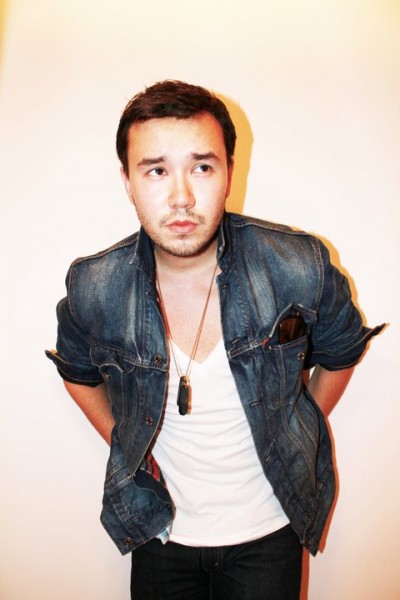 CBM: How old are you and what’s the first magazine you remember reading?
CBM: How old are you and what’s the first magazine you remember reading?
Nate Erickson: I’m 24 years old — the first magazine I remember reading, really reading, were my dad’s old copies of MAD Magazine from the 60s and 70s.
CBM: How did you come to work at VF?
NE: When you graduate in the middle of a recession, you learn to make a lot of friends because you’re going to need them. As it turned out, one of them, who I’d worked on a project for Haiti with back in 2010, referred me to this position and now he’s actually going to be one of my bosses.
I had a series of interviews, from the HR team at Conde Nast all the way up to Graydon Carter, editor-in-chief of Vanity Fair. It was a wild ride and I guess I made a good impression, because here I am.
Lesson? Make friends. Work hard. Be nice to everybody. It pays off.
CBM: How would you describe “the VF voice”?
NE: I think we have a lot of potential with the Vanity Fair voice, making it one of my favorite parts of the job. The magazine itself is so classic, it’s old Hollywood, it’s luxury — we’re letting you see into our world, but from just behind that velvet rope. And for the purposes of what we do — in social media — we’re going to interact. There’s going to be transparency. We want to bring our fans inside. As a nod to the Conde family, I think you combine the sharp wit of the New Yorker with the timeless elegance of Vogue, and there’s Vanity Fair.
CBM: What’s the coolest thing that’s happened to you while working at VF?
NE: My fifth and final interview with Graydon Carter was a dream come true. I’ll keep what we talked about between us, but going in with no idea what to expect, I left with full confidence in the job here at Vanity Fair and the people in charge. It’s an honor to be a part of the family here, and I’m just getting started, I know it’s only going to get better.
CBM: Who’s the coolest person you’ve met on Twitter by running the VF page?
NE: Bianca from Modelinia is one of my favorite people who I’ve met since starting at Vanity Fair. It’s always refreshing when the person behind the account is exactly what you hoped they’d be. She’s done an incredible job to make them a powerful and always-connected voice in the fashion world, and she’s an absolute sweetheart in real life.
CBM: Describe the perfect day at work for you.
NE: Lately I’ll take anything that doesn’t involve another natural disaster striking Manhattan, but to me, a perfect day is when the community is responding to what you do. You’ve got a great piece of content, fans and followers are engaged, and most importantly, it’s not just with you, but with each other. As long as everyone plays nice, that’s a pretty good day.
And no G train construction. That would be perfection.
CBM: What tips and tricks have you learned in your time working in social media for VF?
NE: There will definitely be a lot to learn along the way, but from the accounts I’ve worked on in the past, including broadcasting my own life through @NateErickson, you learn the sooner you deal with a problem, the better.
Samsung North America: Esteban Contreras
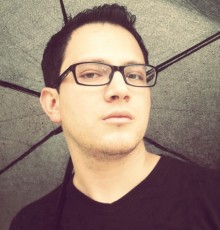 Esteban Contreras manages Samsung USA on Facebook, YouTube, and Flickr as well as SamsungTweets on Twitter. And in his spare time, he dabbles with Fousquare, Tumblr, Gowalla, Curated.by, and says he “can’t wait for Google+ to open up for brands”.
Esteban Contreras manages Samsung USA on Facebook, YouTube, and Flickr as well as SamsungTweets on Twitter. And in his spare time, he dabbles with Fousquare, Tumblr, Gowalla, Curated.by, and says he “can’t wait for Google+ to open up for brands”.
CBM: What are your thoughts on Google+?
Esteban Contreras: In my role I need to work with all social media channels to take full advantage of their respective strengths. Google+ is new and I’m really enjoying exploring it. We’re certainly looking forward to seeing what brand pages will have to offer.
CBM: How did you come to work at Samsung?
EC: I’m originally from Guatemala and went to university in Dallas, Texas. After school, I worked for an IT and business consulting firm. I then started a blog and podcast, which led me to interview many people, including Matt Moller who leads Consumer Engagement for Digital Marketing at Samsung. After the interview that night, I sent him my resume and two months later I was moving to New Jersey. Matt is now my boss. It was an exciting career move for me. It shows who I am: Someone who enjoys talking with others online and is passionate about the convergence of technology, marketing and social media.
CBM: What does your day to day look like?
EC: I make sure we are creating and curating content, and engaging with customers on Facebook, YouTube and Twitter on a daily basis. I collaborate with multiple teams, including customer support and product marketing teams. I’m also very involved in major strategic projects like planning for Samsung @ SXSW, CSR social media efforts, and integrating social media into Samsung.com. My goal is to create meaningful engagement, which can result in deeper customer relationships and advocacy. Aside from our many official accounts, we also have personal accounts where we represent Samsung. On Twitter, I have @SamsungEsteban. I don’t turn off my social accounts on the weekends or nights because there’s always something worth talking about.
Fast Company: Sheena Medina
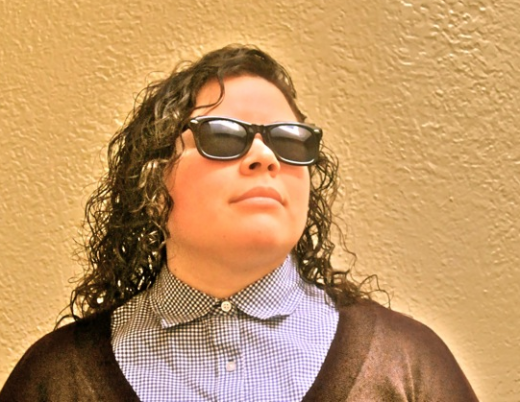
Sheena Medina (one of the most awesome names ever), is from Aurora, Illinois, and spent 6 years in Chicago before moving to New York City to join Fast Company in 2008 as an ad sales assistant.
When Medina took over Fast Company’s social media accounts, the company had 90,000 followers on Twitter and 12,000 fans on Facebook. Now on Twitter, they have 365,000 followers and on Facebook and 38,000 fans. While it’s true the space totally blew up during this time, Medina’s management of the company’s Twitter, Facebook, LinkedIn, and Tumblr accounts sure played its part.
CBM: What’s an average day for Sheena Medina and what tools do you use?
Sheena Medina: I spend a lot of the day in our Yammer chat room with the editors and writers to talk about what stories we’re going to put up for the day. We rotate stories from the magazine into our online coverage and I read all the posts that go up. I spend a lot of time tweeting and scheduling tweets on Tweetdeck. I write Facebook updates for Fast Company and FastCoDesign manually. I see Twitter and Facebook as two different platforms so I keep two very different conversations going.
We recently got into LinkedIn and it’s started to become a heavy source of traffic for us. It’s really grown a lot in the last three months and a lot of our leadership posts do really well there. We regularly update our Tumblr, which has also really taken off since we started it earlier this year.
CBM: How do you decide what type of content to push out to different social networks?
SM: We’re have a feel for what kinds of stories do well in certain places. For Tumblr, it’s not about the content usually but just about the image. But when we’re pushing a story on LinkedIn, it’s all business insights and strategies for small business owners. For Facebook, I pick stories from the day that we can dive into a little bit more. Meanwhile, Twitter is more of our broadcasting platform. We tweet once every 30 minutes or less to stay fresh in people’s minds.
CBM: Have you ever had a total social media meltdown?
SM: One project that’s really comes to mind is “The Influence Project”. The initial reactions to that didn’t go the way we thought they’d go. [Even I slammed the project here.] We had our editors respond to people directly on their blog and website, on Twitter and in the comments of articles, etc.
CBM: What’s your Follow/Friend acceptance policy?
SM: On Facebook, I tend to friend people who I’m really friends with in real life. But on Twitter, I participate in meetup groups with people who are in the social media industry so I try to keep Twitter business-y and related to Fast Company.
 ELLE: Kristina Soriano
ELLE: Kristina Soriano
When Kristina Soriano took over Elle’s Twitter account one year ago, it had 200,000 followers; right now Elle has over 760,000 followers. She’s continuing the grow the brand at a steady rate of 1,000 followers a day.
CBM: How did you come to work at ELLE?
Kristina Soriano: I initially applied for an ELLE.com internship but was—very fortunately—hired as a freelancer to help re-launch the site in 2008, right after I graduated college. After that I became the Assistant Editor for Hachette (then the publisher of ELLE) Digital, and in January 2009 I officially joined ELLE.com’s editorial team as Assistant Editor, which is my current title.
CBM: Describe your daily routine and what tools you use.
KS: I come in and make the first updates to the site, and throughout the day I’ll get some stories from inbook up, spend some time editing ELLEgirl.com, update our Twitter and Facebook, help syndicate our content, and make sure our homepage is always fresh, among other special projects and generally assisting the other editors with anything they need. There’s usually so much going on, so scheduling a tweet or two in advance is always helpful. For that, I use Hootsuite.
CBM: How would you describe “the ELLE voice”?
KS: Conversational, confident…I’d say authoritative. I think of a very modern, cultured woman who’s part of this inner circle but has many interests. She’s also a pretty sharp dresser, of course.
CBM: How has your work affected Twitter, Facebook and Tumblr growth?
KS: I took on ELLE’s social media at the end of last summer. Our Twitter had some 200,000 followers; right now we have over 760,000 followers. We have editors who are great on Twitter, so my job overseeing the brand’s handle is to rep the magazine as a whole, streamline the bigger news, and promote our content in a way that’s relevant and interesting to our followers. I keep it simple and straightforward, tweeting only once or twice an hour.
CBM: Which of your accounts is growing the fastest?
KS: Our Twitter grows at a steady rate of 1,000 followers per day, more or less. When I was managing ELLE’s Tumblr, our following would surge through the roof when we’d get one of our posts on the Radar and especially when we partnered with Tumblr during its big NYFW campaign last season. I think it’s still growing pretty rapidly—our market editor Sydney’s doing an awesome job on it.
I’ve kept a Tumblr of my own since I was a senior in college in 2008, mostly thinking it would just be this neat little outlet for easy, who-cares-mentality “blogging.” It was like this hip, understated way to blog, and I met Rich Tong, Tumblr’s fashion director, a few years back just because we followed each other. Now that it’s blown up and become this new way for a brand to further develop a personality and new followers, people take it seriously. It’s part of people’s job descriptions. So it’s really cool to see how huge and important it’s become for a brand’s social media presence.
CBM: What have been your biggest struggles and how have you overcome them?
KS: I don’t have my own Twitter. I’ve never had one. So I was totally new to the game when I took on ELLE’s Twitter account. I had to learn all the proper etiquette, rules, and verbiage. I was also given a stack of Power Point print-outs of Twitter best practices and strategies, and it turns out half the suggested ideas came across as sponsored tweets or just sounded weird. So it was a very experimental season for me and our Twitter. In time, I just learned—and still am learning—what our followers respond to most, what they find most helpful and newsworthy, and what they don’t care about. I think that’s the important thing.
CBM: Describe the perfect day at work for you.
KS: Is there a perfect day?? Instinctively that means a day without one single technical issue. More realistically, a good day would involve a big news story or two, tons of traffic to the site, some really cool appointments or interviews, and leaving the office at 6.
CBM: What tips and tricks have you learned in your time working in social media for Elle?
KS: Always check your spelling! Everyone’s a mean editor on Twitter when they spot a typo.
 The Next Web: Amalia Agathou
The Next Web: Amalia Agathou
Amalia was one of the first people I started working with at The Next Web. She’d send me these 1,000 word trend pieces on social media that would instantly receive thousands of Retweets and Likes. She was such a rock star. I’ve been struggling to find anyone half as capable to write about social media since she transitioned into her new role at The Next Web as our Social Media and Marketing Director. She’s since grown our Facebook fans by tens of thousands and is rocking our Tumblr. But there’s so much she does behind the scenes that I only see the results of… and did you know she does it all from an island in Greece?
CBM: When did you officially start as our Social Media and Marketing Director?
Amalia Agathou: I’ve been contributing posts to The Next Web since November 2009, while I was still working as an editor for the Greek edition of Glamour magazine. I went on to become a full time social media editor and then the Social Media and Marketing Director in March 2011.
CBM: Why is it so important for a brand like TNW to have someone like you?
AA: No brand can succeed if stays isolated, disregarding its audience, much more a media company that is reporting on the latest advancements in the tech word and how they affect our day-to-day lives. Not having a person in charge of your social media accounts and just checking in randomly is pretty much like having your telephone number printed on your business card and then giving your mobile to your four-year old nephew or bury it in the garden. The minute you set up your accounts you set expectations. People expect that they will interact with another person, that you will reply to them, that they will get something in return out of your online connection. If you don’t have the resources to do that, it is best to do the minimum you can, like going online to the one social network that fits best your audience and be 100% committed to this, than be all over the social sphere as a “ghost”.
CBM: Describe your day to day life- from breakfast to bedtime.
AA: I’m online pretty much 24/7. Although I have official working hours I always keep an eye on our social media accounts, even during holidays and the weekends. It’s always the last thing I do before going to bed. Things may come up, like Steve Job’s resignation a few days ago, that make social media go on fire and you must be there, online, joining the conversation. In my case it’s something I would do anyway as I am tech oriented (notice how elegantly I avoided using the words social media addict), but if you want to be in this business you must be prepared to have flexible work schedule.
CBM: How would you describe the TNW voice?
AA: As our description says on Tumblr’s spotlight we are all about #tech, #geek and #lol, but what I like the most is that TNW speaks many languages. Our audience, as our editors and news, come from all over the world. I think this international character is what makes our community so interesting and vibrant.
CBM: How do you keep up with social media news?
AA: Twitter is my best friend when it comes to news. But I like to get inspiration from unexpected sources to keep my prospective fresh in a social media obsessed world. After all, being socially talented online follows the same principles as being socially graceful off-line. Miss Manners would make a great social media consultant. I’m sure she would advise many brands that not acknowledging someone who is talking to you is rude and a big DON’T.
CBM: You are ROCKING our Tumblr account- tell me about that growth and your Tumblr strategies?
AA: Let’s sum it up in four simple rules.
- Know your audience. People talk about different stuff on social networks. People on Tumblr have a very strong community and have formed their own unwritten rules, like don’t talk about Tumblr outside Tumblr (shhh!!!). You need to respect that if you want to become an equal part of it.
- It takes two to tango. As Miss Manners again would advise, going to a party and talking only about yourself is rude. Reblog, like, follow back and always give credit where it’s due.
- Try to stay relevant. There is really no point if you’re talking planking when everyone is stocking.
- Be nice. I know it’s a cliché but it really works. Try to be helpful, be more of a :) than a :( and stay out of internet drama!
CBM: What do you think TNW could do better in social media?
AA: We’ve only just got started and there is still a lot of room to grow on all social networks. For me the key is not to fall for the trap of “dead” numbers. To twist a quote from The Social Network: Having a million likes or followers isn’t cool but you know what’s cool? Having a billion interactions. Our aim is to keep growing our community in healthy way, connect with our readers and serve their need to stay updated on tech news the best way we can.
CBM: What is it like being so involved in the tech world and working from Corfu?
AA: Sunny weather and beautiful beaches? Not bad as long as I have a good Internet connection. Apart from that I try to travel and attend tech events and conferences because connecting with people and keeping a community together requests being present just as much online as off-line. Nothing brings the geek community closer than arguing over tech obsessions, excitement over new apps and startups and of course beer.
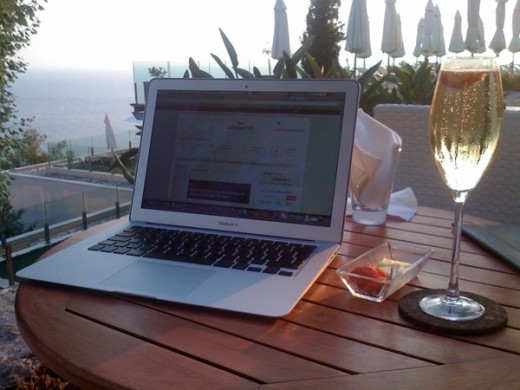
Get the TNW newsletter
Get the most important tech news in your inbox each week.
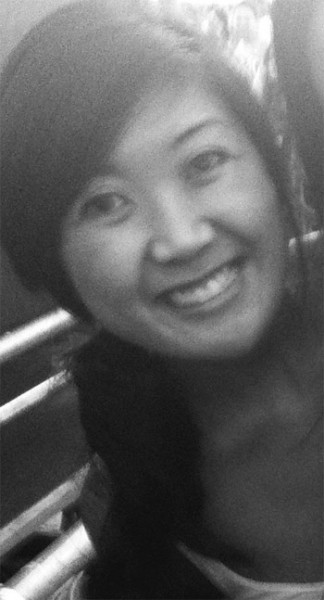
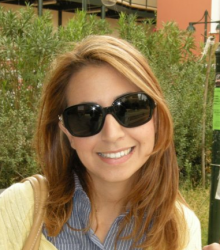 The Next Web: Amalia Agathou
The Next Web: Amalia Agathou


